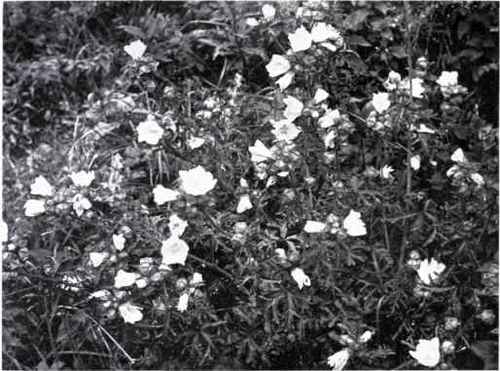Musk Mallow (Malva Moschata, L.)
Description
This section is from the book "British Wild Flowers - In Their Natural Haunts Vol2-4", by A. R. Horwood. Also available from Amazon: A British Wild Flowers In Their Natural Haunts.
Musk Mallow (Malva Moschata, L.)
The Musk Mallow is not found fossil in any deposit. It is a member of the flora of the North Temperate Zone, found in Europe eastward to Lithuania, and it has been introduced into the United States. Though fairly widespread in Great Britain it does not grow in West Kent, Radnor, Cardigan, Montgomery, S. Lincs, Mid Lancs, S.E. Yorks, Renfrew, Peebles, Selkirk, Linlithgow, Mid Perth, and elsewhere; and in the West Highlands only in Dumbarton, Clyde Isles, and S. Ebudes, and in Sutherland in N, Highlands; but in Mid Scotland Watson held it to be an alien. It is rare in Ireland.

Photo. Flatters & Garnett - Musk Mallow (Malva Moschata, L.)
Mountains and hills are the home of the Musk Mallow, which is a rupestral or rock-loving species, delighting to grow on lofty summits where arenaceous or sandstone rocks come to the surface. In the lowlands it may be found in situations where it can command a similar sandy habitat.
The Musk Mallow is a suberect plant, with numerous stems, hairy, tall, and with many branches. The leaves are kidney-shaped at the base, with long leaf-stalks, with 5-7 deep, pinnatifid lobes, divided nearly to the base, with narrow segments, the upper with narrow segments only.
The flowers are rose-pink or white, large, clustered near the summit. The calyx consists of 5 sepals. The outer calyx-teeth are narrow and hairy, the fruit-stalks being erect in fruit, the fruit downy. The 5 petals are nearly blunt at the tip, with veins of deeper colour, branched, fringed with hairs. The carpels are rounded, and covered with coarse hairs on the back.
Often the stem is 2 ft. high. The flowers last and bloom in July and August. The plant is a deciduous, herbaceous perennial.
Musk Mallow is proter-androus. The ends of the anther-stalks curve downwards and unite in a tube round the pistil. When the numerous anthers wither the stigmas spread out above and obviate self-pollination. The visitors are Hymenoptera (Apidae), Apis mellifica, Che-lostoma, Andrena; Diptera (Bombylidae), Systrechus; Le-pidoptera, Hesperia sylvanus.
The seeds are dispersed by the plant's own agency. The capsule, a schizocarp, consists of a number of aggregate carpels which break up when the plant is ripe, and naturally aid in dispersal around the plant, the single seeds remaining in the carpel.
Musk Mallow is a sand plant, requiring a sand soil, and it is found very frequently on such formations as the Middle Lias Marlstone.
A fungus, Puccinia malvacearum, the Hollyhock disease, is parasitic on it. The Swift Moth (Hepialus sylvanus) and Eubolia ceromata live on this food plant, and 3 beetles, Podagrica fuscipes, Crepidodera fusci-cornis, C. rufipes.
Malva, Pliny, is from the Greek malakos, soft, and is Latin for Mallow, given because of its emollient characters. Moschata (Latin) refers to its musk-like scent. This pretty wild flower is called Musk Mallow because its foliage has a musky odour.

Photo. Matson - Musk Mallow (Malva Moschata, L.)
In Germany an ointment was made from the leaves, and used to dispel malicious influences. The carpels called cheeses are termed "fairies' cheeses". The Musk Mallow was said to encourage love. Gerarde has the following couplet:
"If that of health you have any special care, Use French Mallows, that to the body wholesome are."
The seeds were said to nourish the dead, so the Greeks planted the plant on graves. Like other members of the Mallow tribe Musk Mallow yields fibres of excellent quality. The Chinese use one as food. It is cultivated in gardens, and is easily improved.
Essential Specific Characters:63. Malva moschata, L. - Stem erect, radical leaves reniform, crenate, with pinnatifid lobes, upper leaves lobed, flowers large, rose-pink, calyx lobes narrow, fruit hairy.
Continue to:


